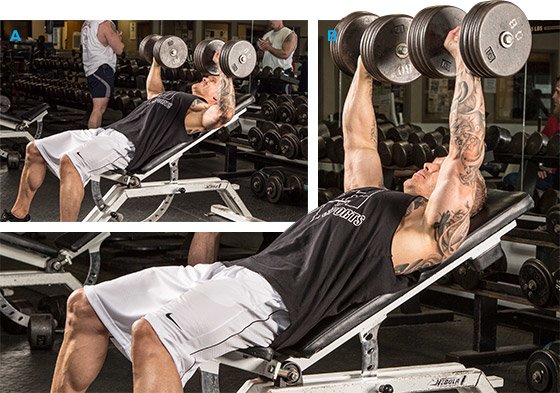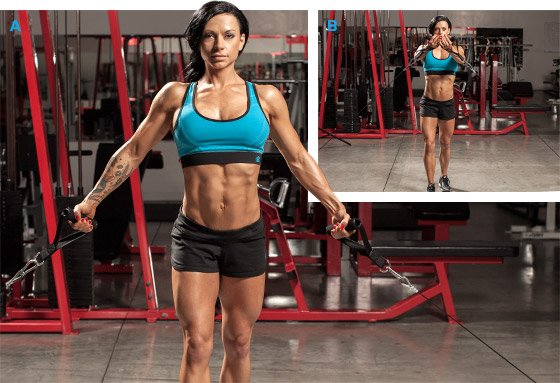Speed up your lagging upper-chest development with these 7 strategies, exercises, and techniques!
 If your chest workout is always ordered something like this—flat bench press, incline press, decline press, fly—you've got all the makings of a complete chest workout.
If your chest workout is always ordered something like this—flat bench press, incline press, decline press, fly—you've got all the makings of a complete chest workout.




 If your chest workout is always ordered something like this—flat bench press, incline press, decline press, fly—you've got all the makings of a complete chest workout.
If your chest workout is always ordered something like this—flat bench press, incline press, decline press, fly—you've got all the makings of a complete chest workout.
That's not to say, however, that you're going to have complete chest development.
If you're always doing a middle-chest movement first, when your energy levels are highest, and attacking your upper and lower chest when you're fatigued, guess which region will eventually start to lag?
Bodybuilders who follow the "flat bench first" approach usually have deficiencies in their upper and lower chest that start showing up over time.
And some bodybuilders simply have genetic deficiencies in a particular area, which forces them to redouble their efforts to bring up their upper pecs.
If you're looking to build more thickness, muscle, and strength in your upper chest, here are seven ways you can quickly restructure your training to address your weakness.
If you have any more ideas that we haven't addressed here, please add your two cents in the comments section at the bottom of the article.
1
START WITH A MULTIJOINT UPPER-CHEST MOVEMENT
The simplest and most obvious solution to emphasize your upper pecs is to target them firston chest day. So, instead of starting your workout on the flat bench, start with the incline bench press.
By flipping exercises, you'll find that you're significantly stronger and can lift a little more—or do a few more reps with a given weight—than you could when you did an upper-chest move later in your workout. Forcing your upper pec fibers to lift more than they're accustomed to will set you on the road to making gains.
By all means, since you'll now be a little stronger on inclines, don't be afraid to use a slightly more challenging weight. Nothing stalls progress more than choosing a weight you can already handle for 3 sets of 10. If you normally do sets of 8-10 with inclines, do a set or two (after warming up) for 6-8 reps to make those fibers work even harder.
There are benefits to doing either a barbell or dumbbell movement here, and both are good choices. You may find that the following points will help you decide which to opt for as your lead exercise, but you definitely want to steer away from a machine exercise. Your body has to work harder—and harder work equates to more muscle stimulus and growth—with free weights.
2
GET OFF THE FIXED BENCH
If you take a closer look at incline barbell bench-press stations, you'll notice that the angle of the bench is typically fixed, usually around 45 degrees. (I've seen some benches that are even steeper than that, and they end up working the delts rather than the upper pecs.) There's no law in physics that says the upper pecs have to be worked from the same angle all the time; in fact, you'll get better overall upper chest development if you use a variety of incline bench positions.
Now take a look at that adjustable incline bench. There are several notches on the bench that allow you to work low inclines, moderate inclines, and even steeper inclines. If you really want to improve your upper pecs, this adjustable bench is your new best friend, and you'll make use of all those in-between positions at some point.
The adjustable bench is best utilized with dumbbells or in the Smith machine. Start using a variety of inclined positions—either from set to set or workout to workout—to target the muscle fibers in slightly different ways.

INCLINE DUMBBELL BENCH PRESS
3
DO A SECOND UPPER-CHEST EXERCISE
One way to target a lagging body part is to do more exercises that focus on it. What you donot want to do, however, is simply repeat what you did with the first move.
For instance, let's say you did an incline barbell press for sets of 8 reps on the first exercise, and now you're going to do another movement. Which of these would add a different stress to the target muscle?
A: The Smith-machine incline press on an adjustable bench set to the same angle as the fixed-incline barbell press for sets of 8 reps.
B: A dumbbell press with a lower degree of incline than you used on the fixed bench for sets of 10-12 reps.
I hope you chose B. If you want to change the training stimulus to work a target muscle in multiple ways, you should opt for different equipment, change the angle of the bench, and work with a different relative intensity. Just doing a second upper-chest movement isn't enough unless you're taking into account all these factors.
4
DON'T STOP AT FAILURE
If you want to optimize muscle growth, you can't fear muscle failure. If you just drop a weight after you reach 10 reps, but you could've done 1-5 more reps, then you're not doing a true set of 10.
Pushing past your limits—which, by the way, should be cycled with periods of lower-intensity training—will break down additional muscle fibers and stimulate more growth as long as you take only a few sets past muscle failure. (Taking every set past muscle failure could lead to acute overtraining.) The best advice is to take 1-2 sets of a given exercise beyond muscle failure, typically on your last or your heaviest set.

There are plenty of good advanced-training techniques available when it comes to chest day. If you've got a workout partner, consider:
- Forced Reps: You do as many reps as you can on your own, and then your partner helps you with just enough assistance to keep the weight moving upward for a few additional reps.
- Negatives: As you reach muscle failure, your partner provides you with a lot of assistance lifting a weight, but then you take a full five seconds to lower it, focusing on the negative contraction. Do as many reps as you can until you can no longer control the negative. This technique works better on barbell and most machine movements than with dumbbells.
If you don't have a training partner, here are two to try:
- Rest-Pause Clusters: Choose a weight you can lift for 7-8 reps, but do just 3-4 reps and then rack the weight. Rest 20 seconds and do 3-4 more reps. String together 4-5 work segments, interspersed with 20 seconds of rest, and you'll end up with about 15 reps using a weight you'd normally only be able to lift for 7-8 reps. This is best done with machines that allow you to easily get into and out of the start position.
- Dropsets: When you reach muscle failure, rather than just dropping the weight, instead reduce the poundage by about 25 percent and continue the set to a second point of muscle failure. This is best done with pin-loaded machines, cables, and dumbbells. Be sure to have all the right weights in place before starting your set.
5
CONSIDER A SECOND CHEST DAY
If you follow an intermediate- or advanced-level training split in which you're working each body part once every five days or more, you can add a second chest workout in your split as long as you're careful about how you insert it.
In the short term—say, no more than about 6-8 weeks—doing a second chest day allows you to intensely focus on bringing up a lagging area. The idea here is not to simply repeat the same chest workout you did a few days earlier, but to provide for some new and novel exercises and techniques. In that sense, your second session might not only differ in terms of exercise selection, but also by the target rep ranges, intensity boosters, rest periods, and other training factors.

If you follow this approach, how you set up your split becomes critical. You need to ensure that you're not training any of the "push" muscle groups on back-to-back days, so there's ample recovery time built in. Here's what a poorly constructed split might look like: chest on day one, shoulders and back on day two, arms and legs on day three, chest on day four, and so on.
Build in at least 48 hours between workouts that really tax your push muscles—chest, shoulders, triceps—to better optimize growth. A sample split that includes a second chest workout might look something like this: chest and triceps on day one, back and biceps on day two, rest on day three, chest and shoulders on day four, legs on day five, rest on day six, and so on.
6
TRY "NEW" UPPER-PEC MOVEMENTS
If new and novel upper-chest movements are so important to hitting those upper pec fibers, we'd be remiss not to give you some ideas as to where to start. Assuming you're familiar with the basic upper-chest movements, consider these:
- Semi-inclined bench press: Whether done with dumbbells or in the Smith machine, doing your presses with in-between angles on an adjustable bench brings new life to an old favorite.
- Incline machine press: Instead of hitting your usual machine, use the machine you typically don't favor. In addition, if your gym has a Hammer Strength chest machine in which each arm moves independently, sit sideways to the unit, brace yourself with your free hand, and press across your body.
- Single-joint incline fly: You probably already do some kind of single-joint movement in your workout, but make it one that focuses on the upper pecs. A few good choices are cable crossovers from the lower pulleys, incline-bench cable flyes, and incline-bench dumbbell flyes.
- Reverse-grip bench press: Flat-bench barbell presses with a reverse grip actually shift the focus to the upper pecs. Start out light and make sure your thumbs are hooked around the bar for safety.
- Incline-bench pull-overs: Ditch the flat bench for your pullovers and do them on an incline bench instead. Do 3 sets of 12, holding that last rep for a five-second isometric to really feel the burn.

LOW PULLEY CABLE CROSSOVER
7
DO YOUR CHEST WORKOUT AFTER A REST DAY
One last tip on getting a great workout: Target your lagging body part after a rest day on which you've eaten clean, taken it easy, and prepared your mind to move some iron. If you're tired when you get to the gym, you're probably not going to have a boundary-breaking workout.
Some pre-workout cocktails are great for increasing your focus and intensity, but don't solely rely on them all the time. Getting enough sleep and eating well are probably the two most important factors in your ability to have a great workout.
GET UP
Ultimately, if your upper pecs are lagging, it would be insane to continue doing what you're doing and expect any different results. Follow these tips, and you'll be on the road to building a fuller, more complete chest, starting with your very next workout!


This blog website is pretty cool! How was it made !
ReplyDeletetricep workout